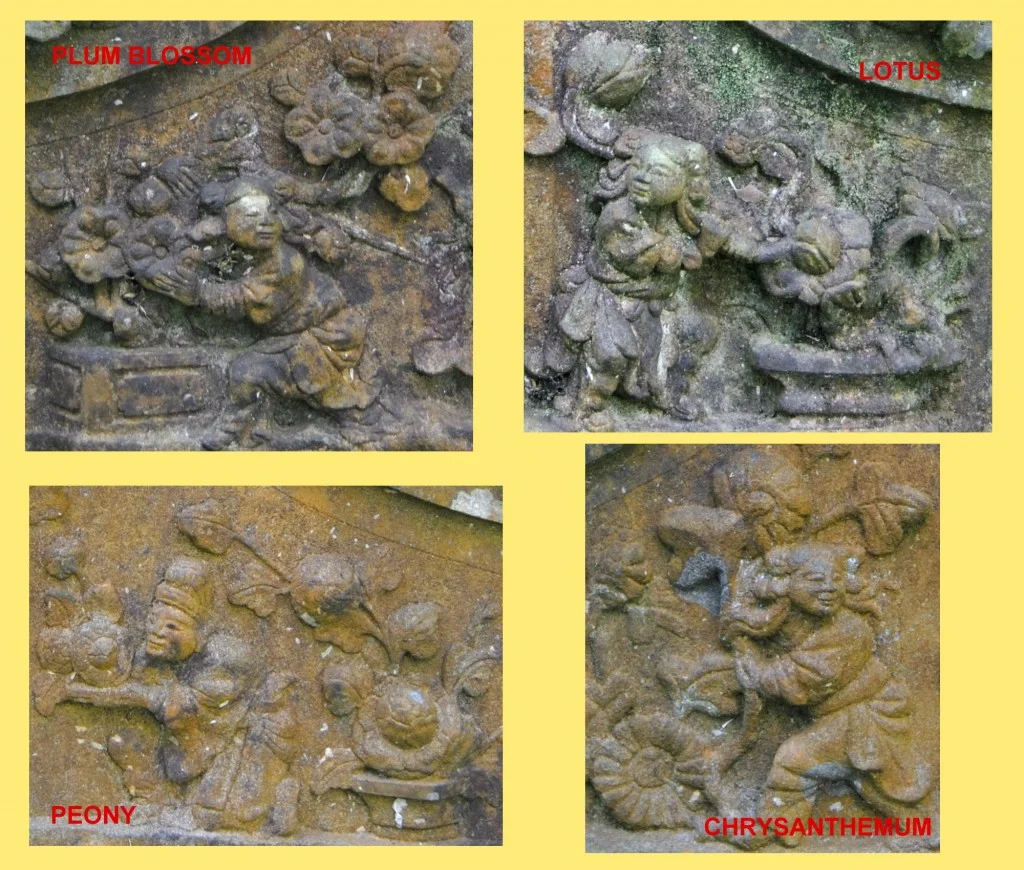02 CHIA WAN NEO 谢圆娘
The Four Loves
CHIA WAN NEO 谢圆娘 1864–1932 Place of Ancestry Leong Khay (龙溪)
The intricate carvings on Chia Wan Neo’s tomb befit her stature as a matriarch with three generations of descendants at her wake. The panels on the tomb shoulders depict two out of The Four Loves in Chinese culture: four poets and their favourite flowers, each representing a season. On the left shoulder (from the viewer’s point of view) is the lotus growing out of a container in summer.
The Lotus (蓮)
自李唐來,世人甚愛牡丹。予獨愛蓮之出於泥而不染,濯清漣而不妖。
“Since the Tang Dynasty, many have loved the peony. My fondness is solely for the lotus as it stays untainted even though it grows in mud. After cleansing with water, it does not become bewitching”.
“Ode to a Lotus” by Song Dynasty’s Zhou Dunyi (周敦頤) is also an allegory of how a gentleman should behave – true to his principles while navigating the treacherous paths of the world.
The Peony (牡丹)
The peony (牡丹) was the favourite flower of Emperor Xuanzong (唐玄宗) of the Tang Dynasty. During his reign, the Tang Dynasty reached its height of power for the country and the capital city Chang’an (长安) was renowned for its opulence with residents leading luxurious lives. At a palace banquet celebrating the full bloom of peonies, Emperor Xuanzong requested the poet Li Bai (李白) to compose a poem appropriate for the occasion. Li Bai promptly created a verse that compared the beauty of the flower to that of Lady Yang Guifei (楊貴妃), the Emperor’s favoured consort and one of the four classical beauties of ancient China. Unfortunately, Yang Guifei met a tragic end when she was accused of bringing down the empire, though to this day, the vibrant peony continues to symbolise wealth and prosperity.
The Plum Blossom (梅)
In contrast to the celebration of material life during the Tang Dynasty, the Song (960–1279) scholars focused on cultivating the inner spirit. Weak administration and defeats abroad led many to shun official positions and opt for reclusive lives to uphold their principles. The era’s favoured flower was the plum blossom (梅), admired for its delicate beauty and resilience in winter. Poet Lin Bu (林逋) epitomised this trend – a bachelor who lived simply, uninterested in fame or wealth. He devoted himself to cultivating plum trees and raising cranes to such an extent that his contemporaries made an apt comparison: “The plum tree is as his wife and the cranes his children”.
The Chrysanthemum (菊)
Unlike the plum blossom with its lofty attributes, the chrysanthemum is a much simpler flower symbolising a carefree life. Tao Yuanming (陶淵明), a Song Dynasty poet who chose to stay away from court intrigues, retired to spend his days with his beloved chrysanthemum flowers, capturing his tranquil state of mind in his poetry.
採菊東籬下 悠然見南山
“While picking chrysanthemums ’neath the Eastern fence
My gaze upon the Southern mountain rests”
(Adapted from translation by Yang Xianyi and Gladys Taylor)
Only the lotus and plum blossom appear on Chia’s tomb. You can see the full set of flowers below.
by Catherine Lim


Recent Comments